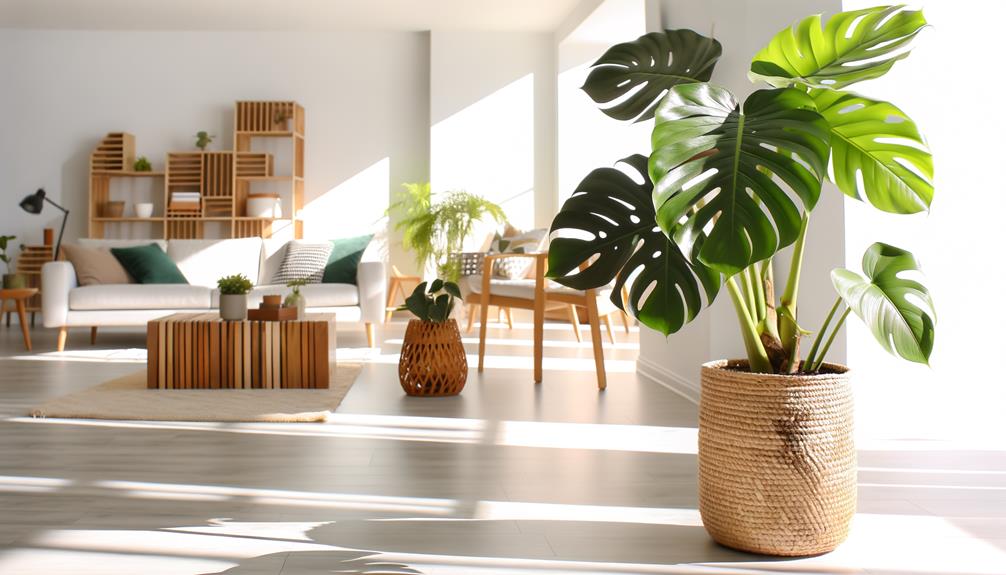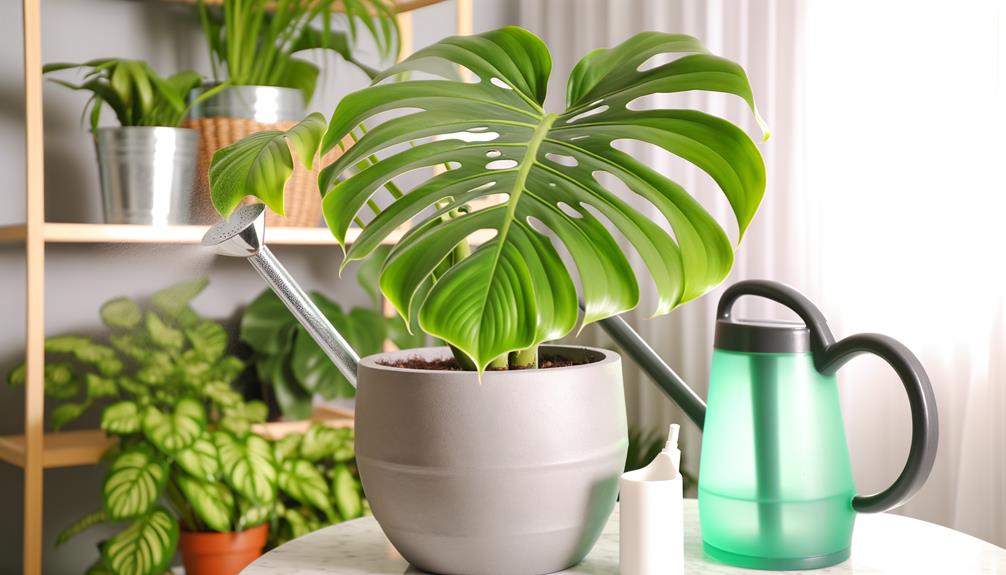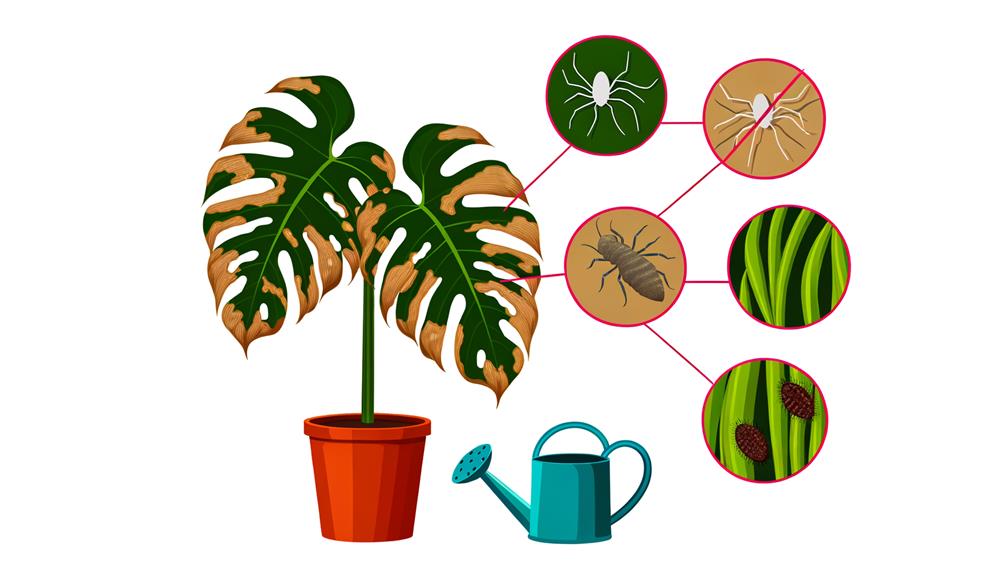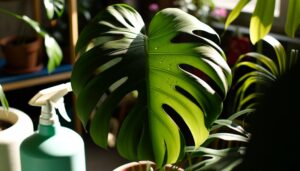Is Monstera Albo Worth It
Monstera Albo, with its striking variegation, is indeed worth the investment if you appreciate botanical rarity and aesthetic appeal. Its unique chlorophyll mutation requires specific care: high humidity, bright indirect light, and well-draining soil.
The variegated leaves result in slower growth and lower photosynthesis efficiency. Prized for its beauty and genetic rarity, Monstera Albo commands premium prices and demands precise cultivation conditions.
However, it's more compact and sensitive compared to its non-variegated counterpart. If you're willing to provide the ideal environment, this plant can become a centerpiece of your collection.
Learn more about its care and the unique challenges it presents.

Key Takeaways
- Monstera Albo's rare variegation makes it a prized and visually appealing addition to any plant collection.
- The plant demands specific care, including high humidity and well-draining soil, which may be challenging for some growers.
- Its slow growth rate and genetic variability contribute to its premium price and limited availability.
- Investing in Monstera Albo supports genetic diversity and botanical rarity, enhancing its value for collectors.
- Alternatives like Monstera Deliciosa or Philodendron Birkin offer similar aesthetics with easier maintenance and lower costs.
Origin and Background

The Monstera Albo, a variegated cultivar of Monstera deliciosa, traces its origins to the rainforests of Central America, where it thrives in the humid understory. You'll find it climbing trees, using aerial roots to secure itself while seeking light.
This plant's natural habitat offers high humidity, filtered sunlight, and well-draining soil rich in organic matter. It's adapted to these conditions, making it essential to replicate them for best growth in your home.
The genetic mutation responsible for its variegation occurs naturally but is relatively rare, contributing to its desirability and higher market value. Understanding its origins helps you appreciate why it requires specific care conditions and why it's considered a prized specimen among plant enthusiasts.
Appearance and Variegation
You'll appreciate the Monstera Albo's unique leaf patterns, characterized by striking variegation that results in a mosaic of green and white.
This color contrast greatly impacts its visual appeal, making it a standout in any plant collection.
Additionally, its growth habit differs from other Monsteras, often displaying more compact and controlled development.
Unique Leaf Patterns
Often revered for its striking beauty, Monstera Albo features unique leaf patterns that showcase intricate variegation, making it a prized specimen among plant enthusiasts.
The variegation results from a mutation in the chlorophyll production, leading to patches of white or cream interspersed with green. This heterogeneity in pigmentation creates a mosaic effect, enhancing the aesthetic appeal.
Each leaf exhibits fenestrations—natural holes or splits—that evolve as the plant matures, adding to its allure.
You'll notice that the distribution of variegation varies, with some leaves displaying marbled patterns while others have bold, white sectors. This unpredictability not only elevates its desirability but also emphasizes the plant's individuality, ensuring no two Monstera Albo are identical.
Color Contrast Impact
Have you ever wondered how the stark contrast between the white and green sections of Monstera Albo leaves not only enhances its visual appeal but also influences its overall growth and health? The variegation, caused by a genetic mutation, creates a mesmerizing mosaic that captures light differently, affecting photosynthesis efficiency.
| Aspect | Impact |
|---|---|
| Aesthetic Appeal | Increased due to striking variegation |
| Photosynthesis | Reduced in white sections |
| Growth Rate | Slower due to less chlorophyll production |
| Health Maintenance | Requires balanced light and nutrients |
The white areas lack chlorophyll, essential for photosynthesis, thereby reducing the plant's energy production. Consequently, you'll notice slower growth and a need for ideal light conditions to support the green sections. This unique variegation demands careful attention but offers unparalleled beauty.
Growth Habit Differences
While Monstera Albo shares many characteristics with its non-variegated counterparts, its unique variegation alters its growth habit and overall appearance to a large extent.
The variegation, caused by a genetic mutation, results in patches of white or cream-colored sectors on the leaves, which reduces chlorophyll production. This diminished chlorophyll impacts the plant's photosynthetic efficiency, leading to slower growth rates compared to the fully green Monstera deliciosa.
Additionally, the variegated leaves are more prone to sunburn, necessitating indirect light conditions. You'll notice that the Albo's growth pattern is more compact and less vigorous, making it a bit more challenging to achieve the same lush, sprawling aesthetic typical of non-variegated Monsteras.
Proper care is essential to maintain its striking appearance.
Care Requirements

To properly care for your Monstera Albo, you need to understand its light and watering needs, as well as its humidity and soil preferences.
This plant thrives in bright, indirect light and requires consistent moisture, but avoid waterlogging its roots.
Additionally, maintaining high humidity and using a well-draining soil mix will promote excellent growth and variegation.
Light and Watering Needs
Guaranteeing ideal growth for your Monstera Albo hinges on providing sufficient light and maintaining a consistent watering schedule. Place it in bright, indirect light to replicate its natural habitat; direct sunlight can scorch its leaves.
Monitor the plant's moisture level attentively, as overwatering can lead to root rot. It's best to water when the top inch of soil feels dry. Using a moisture meter can offer precision. Ensure proper drainage to prevent waterlogging.
During the growing season, anticipate watering more frequently, while in winter, reduce the frequency. The Monstera Albo's variegated leaves require more light than fully green counterparts to photosynthesize efficiently.
Humidity and Soil Preferences
Maintaining a humid environment around 60-70% is crucial for the Monstera Albo to thrive, as it mimics the tropical conditions of its native habitat.
You can achieve this by using a humidifier or placing a tray with water and pebbles near the plant.
Soil composition is equally critical; opt for a well-draining mix rich in organic matter. An ideal substrate combines peat moss, perlite, and orchid bark to guarantee aeration and moisture retention.
Regularly check the soil pH, aiming for a slightly acidic to neutral range (5.5-7). Overwatering can lead to root rot, so let the top inch of soil dry between waterings.
These conditions will facilitate healthy growth and vibrant variegation in your Monstera Albo.
Growth Rate
Monstera Albo's growth rate can be surprisingly vigorous under ideal circumstances, making it a fascinating subject for both novice and experienced botanists. When provided with prime light, humidity, and nutrient-rich soil, you can expect substantial development. The variegation pattern, a key feature, doesn't hinder its overall progress. However, it's important to understand that Monstera Albo requires consistent care to achieve its rapid development.
Regular pruning and appropriate support structures, like moss poles, will facilitate vertical expansion. Monitoring for pests and diseases is crucial, as they can greatly impact growth rates.
With the right conditions, you'll witness new leaves unfurling every few weeks, each more impressive than the previous. This makes Monstera Albo not only a visual delight but a rewarding horticultural pursuit.
Market Price

Given its vigorous growth rate and striking variegation, it's no surprise that Monstera Albo commands a premium price in the market. You'll often find that prices for a well-variegated specimen can range significantly, reflecting factors like leaf size, variegation pattern, and overall plant health.
The chimeric nature of its variegation means each leaf's appearance can vary, adding to its desirability and market value. Tissue culture propagation techniques haven't yet been perfected for Monstera Albo, contributing to its higher cost.
It's crucial to acknowledge that investing in a Monstera Albo isn't only about aesthetics but also about supporting a plant with unique genetic diversity. Be prepared to pay a premium for this botanical gem.
Rarity and Availability
The rarity of Monstera Albo stems from its unpredictable variegation and the limited availability of mature, well-variegated specimens in the market. Variegation occurs due to a genetic mutation causing irregular white or cream-colored patches on the leaves. This unpredictable trait can make propagation challenging, as not all cuttings will inherit the desirable variegation.
You'll find that sourcing a Monstera Albo with consistent, attractive variegation is difficult. The propagation process requires careful selection and nurturing, often resulting in a scarcity of high-quality plants.
Additionally, the slow growth rate of Monstera Albo adds to its limited availability. Consequently, the combination of genetic variability and cultivation challenges makes this plant a rare and coveted addition to any collection.
Common Problems

Despite its appeal, cultivating Monstera Albo presents several challenges that can frustrate even the most experienced plant enthusiasts. One primary issue is its susceptibility to root rot, often caused by overwatering or poor drainage. You'll need to make sure your potting mix provides excellent aeration and drainage characteristics.
Another concern is the plant's sensitivity to low humidity. Monstera Albo thrives in high-humidity environments, so you'll likely need a humidifier to maintain ideal conditions.
Additionally, its variegation, although stunning, can make it more prone to leaf burn under intense light. Indirect light is essential to avoid this.
Alternatives to Consider
Exploring alternative plants can offer you similar aesthetic appeal with fewer maintenance challenges. Consider the Monstera Deliciosa, which shares the iconic fenestrated leaves but is less demanding. It thrives in indirect light and has a robust growth rate.
Another option is the Philodendron Birkin, boasting striking variegated foliage with less susceptibility to pests and diseases.
For a unique touch, the Epipremnum Aureum, commonly known as the Golden Pothos, provides cascading vines and is exceptionally hardy. These alternatives require moderate watering and tolerate a range of light conditions, making them ideal for both novice and experienced plant enthusiasts.
Conclusion
To wrap up, if you're thinking about getting a Monstera Albo, it's important to balance its striking variegation with its care needs and market price.
Notably, Monstera Albo cuttings can sell for over $200, showcasing their scarcity and appeal.
While they may need extra care compared to other indoor plants, their distinct look and growth potential justify the investment for passionate plant lovers.
Always assess your capacity to meet its care needs before committing.






